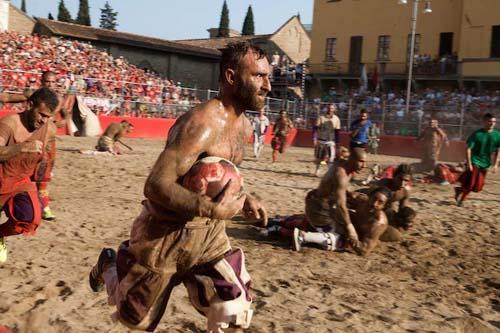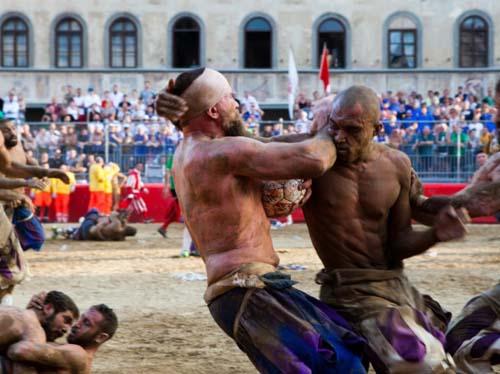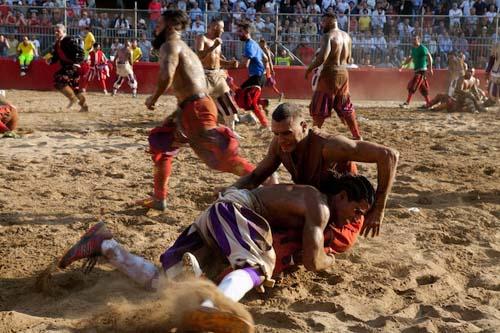
Why Italy still plays this Renaissance sport
Rome: Visit Treia, a tiny hilltop town in the Marche region of Italy, and any local will tell you proudly that the town is known for “bracciale.” Visit in the run-up to August, and you’ll see signs everywhere advertising that same “bracciale.”
You might be confused — after all, any dictionary will tell you that “bracciale” is Italian for “bracelet.” Why are these people so proud of their bracelets, you’ll ask yourself, staring in the window of the town’s only jeweler.
Things get even more meta if you go into that jeweler, Creazioni Oro, and ask for a “bracciale,” because you’ll likely be asked whether you mean a “bracciale” or a “bracciale col bracciale” — a “bracelet with the bracelet.”
Because in Treia — as in towns all across Italy in the past — bracciale is also the name of a popular sport.
Known as “il gioco del pallone col bracciale” (the ball and bracelet game), “Il gioco del bracciale” (the bracelet game) or, simply, “bracciale,” it’s a team sport that dates back to the Renaissance period.

Roughly a cross between tennis, squash, volleyball and cricket, it was Italy’s most popular sport until the 20th century. Its players were the sports stars of the time, feted across the country. And the game even made its way to other European countries, before being wiped out when soccer took hold.
Today, though, some Italians still play bracciale — and in towns like Treia, it’s part of their heritage. They have an annual match, the “Disfida del Bracciale,” held in the town carpark every August. The Treiesi learn the game as youngsters; the best of them make the four teams taking part in the annual Disfida (“challenge”). And that “bracciale col bracciale” made by the local jeweler is testament to their love of the game: a silver bracelet with a charm in the shape of the “bracelet” used to play the sport for hundreds of years.
Cute as it sounds, that “bracelet” looks more like an instrument of torture than a piece of sporting equipment.
The “bracciale” is a wooden cuff that goes the whole way around the hand — players make a fist to insert their hands wrist-deep inside it. It’s also studded all over with spikes.
The “battitore” (“batter”) uses the cuff to hit the ball — which has been thrown to him by a figure called the “mandarino” — onto the other side of the pitch.
The “spalla” (“shoulder”) must send the ball back, aided by the “terzino” (“third player”).
And the ball? This is no tennis ball. Handmade of leather strips carefully stitched together, it weighs a mammoth 300 grams, or over 10 ounces, and is nearly five inches in diameter.
It sounds almost like tennis doubles, only with a third person — but it’s a little harder than that. The spikes on the bracciale can send the ball flying in a totally different direction than the one you hit it in. What’s more, to make it harder for the other team to return it, instead of batting it directly towards them, the battitore aims the ball at a wall, so that it rebounds into the other team’s half, ideally catching them by surprise.
“The movements seem very similar to tennis, but actually they’re very different — in tennis movement from the wrist is crucial, whereas with bracciale it’s a rotation that leads from the shoulder,” says Leonardo Piermattei, the terzino for Treia’s Borgo team, who’s been playing since he was a child.

“It’s not a massively complicated game to play, but you need a certain strength and precision, especially to hit the ball in the right place. You also need to be nimble on your feet to position yourself in the best way beneath the ball, in order to hit it best.” You also need resistance — if the ball hits you in the knee or lands on your foot, with its heavy weight, you sure will feel it.
The weighted balls are hand-stitched by artisans, like Treia’s Daniele Rango. The weighted balls are hand-stitched by artisans, like Treia’s Daniele Rango.
Bracciale wasn’t always a sport bringing locals together. In fact, it started as a game for the elite, say Leone Cungi, who’s written several books about the history of bracciale.
Calling it a “very long journey,” he says the sport as we now know it probably originated in the mid-1500s — although he says it was probably derived from a Roman game, “follis,” in which a large ball inflated with air is hit by hand — hands wrapped in linen or wool for protection.
The bracciale itself — the wooden “sleeve,” as Cungi calls it — was an invention of the Renaissance courts of Italy, probably from the central regions. He calls Tuscany the “cradle” of the game.
Another theory is that it was born at the court of Ferrara — a city whose Renaissance culinary traditions are still going strong. The Este family had a full-on “laboratory” of ball games, he says. It was at Ferrara that writer Antonio Scaino wrote a 1555 treatise on ball games, dedicating it to ruler Alfonso II d’Este who played the game and employed a five-strong team of players. Go to Ferrara today and you’ll see a painting of the game in the castle — the oldest representation of bracciale, dating back to 1574-6.
The Medici family were also fans. Cosimo II de’ Medici, Grand Duke of Tuscany, organised public matches in Via dei Tornabuoni — now one of Florence’s main shopping streets — in 1618 and 1619.
But mainly, says Cungi, it was a game for the upper classes, played within their palazzos and palaces, and extending its reach across the nobility of Europe — French, Dutch, German and even English aristocrats used to play it.
“Gradually, it moved from inside the palace courtyards to outside,” he says.
The upper crust were not amused to see their rarefied game being played by the masses. Not least because playing bracciale involves the use of a wall — which usually belonged to them.
“You can imagine what happened when they played,” he says, citing priests and religious orders who joined forces with wealthy locals to complain about damage to their buildings.
But as the sport got more and more popular, it became a game for the masses. And rather than languid toffs being the ones to strap the bracciale onto their hands, soon, ordinary young men were becoming the first professional players of the ball game.
Perhaps the most famous was Carlo Didimi, who was born in Treia in 1798. Not only was he an exceptional player — particularly good in the battitore role — but his good looks and raffish earring turned him into the David Beckham of his day.
One of Italy’s most famous poets, Giacomo Leopardi, dedicated his poem, “To a Winner at the Ball [Game],” to Didimi, calling him “luxuriant in your youth” and talking of the arena “echoing” with the cheers of his fans.
“These players traveled round Italy, putting on a show,” says Cungi, who calls them “companies,” and says they’d roll into town for up to a month, rather like circuses. The players would regularly switch roles in the “team” to keep the fans coming back. Bankrolled by impresarios, the companies would charge people an entrance fee, and encourage betting on the results.
By the start of the 19th century, cities all around the country (which had yet to unify as Italy) were constructing “sferisteri” — hulking great arenas to host these blockbuster games. They were the first sports stadiums built in Italy.
The sferisterio in Florence still exists, while that of Bologna is now a gym. The most beautiful, and biggest, of all, however, was in Macerata, in the Marche region — just over the hills from Treia. Today, it’s still called, simply, Lo Sferisterio.
“There was no model for it — there’s absolutely nothing that resembles it in any way,” says Silvano Iommi, an architect and Macerata’s councilor for city planning.
The 10,000-seater, Neoclassical sferisterio is a jaw-dropping cross between a Roman-style amphitheater and a fancy opera house, shaped like an oval that’s been sliced in half. In fact, the group of betting associates who built it had such grand plans for it that they took inspiration for its design from the Royal Crescent in Bath, UK.
Dozens of imposing Doric columns gird the curved side, with two tiers of box-style seating between each pair — intended for the associates who built the arena.
Below them are seats for the public, who paid an entrance fee and placed bets on the games — not just bracciale, but athletics and gymnastics, bullfighting, and dog and horse races.
There were military parades, hot air balloon launches and even musical shows. But bracciale was always in the air, thanks to the high, dead-straight wall slicing down the back.
With its first stone laid in 1820 and a nine-year building process involving luminaries such as the Brera Academy of Fine Arts in Milan, and even the Vatican, Macerata’s sferisterio was an enormous project.
Part of the city walls was demolished, along with a 16th-century fortress. The medieval area of town, behind the sferisterio, would be changed forever — the massive wall took away its sunlight, “totally throwing it into shadow, leading [the area] into an unstoppable decline,” says Iommi.
The sferisterio followed suit — the initial estimate to build it had been 10,000 “scudi,” but the final cost was 20 times that. As a sports arena, it was doomed from the start.
Today, after a chance discovery of its incredible acoustics in the 1920s, the sferisterio is an outdoor opera house, home to the highly regarded Macerata Opera Festival, which takes place each summer. A proper stage has been constructed over the former arena floor, and nabbing a seat in one of the “boxes” is a bucket list event.
By the 19th century, bracciale was Italy’s national sport. Traveling companies were putting on shows all across Italy, its islands, and even the mountain regions, which at that point were part of the Austro-Hungarian Empire. The rules had been simplified, the balls halved in size and weight, and the Renaissance-era teams cut from four to three to hone the game. But there were problems looming.
“There were lots of wars in the 19th century,” says Cungi. “The season for the game started in spring and finished in autumn, and that was the time wars were taking place, too. So there were also enforced pauses because of military or political events. But they played on, even with interruptions.”
But although in some sferisteri bracciale was being played daily up until the First World War, what Cungi calls the “emerging Anglo Saxon sports” such as cycling and soccer proved the death knell for the game, hastened by the Second World War, which put an end to bracciale as a professional sport.
“Gradually, the game faded out,” he says. In the postwar period it disappeared from the big cities entirely, and was only played in smaller towns, going back to its roots in central Italy.
Cungi namechecks Treia and Mondolfo in the Marche region, and Faenza and Santarcangelo di Romagna in neighboring Emilia Romagna, as towns that kept the tradition going. The first two turned their matches into full historical reenactments — something that saved the game, says Cungi: “People had stopped playing, but it came back in the 1970s and 1980s because of these historical reenactments.”
Bracciale was back. In 1992 a national committee of the game was founded, and a championship was established, with towns taking part including Cungi’s native Monte San Savino in Tuscany. Today, that committee is called the National Association of the Gioco del Pallone, and it organizes games across Italy.
Treia’s annual Disfida usually takes place on the first Sunday of August, with the town’s four teams playing each other with the stark white uniforms of the 19th century — though Piermattei says the style of the game is more 18th-century. The town’s main team, named after the great Carlo Didimi, has won the Italian championship several times.
Monte San Savino’s annual tournament, on the other hand, takes place with 16th-century costumes on June 16. Both are played against the city walls — in Treia’s case, the old bracciale pitch is now a parking lot, which is cleared for the games.
Other towns that still compete are Macerata and Mondolfo in the Marche region, Chiusi, Florence and Arezzo in Tuscany, and Santrcangelo di Romagna and Faenza in Emilia Romagna. The local teams travel for tourmanent games, playing in venues from city-wall parking lots to Florence’s sferisterio.
For those of us used to watching fast games like soccer or tennis, bracciale can seem boring, says Cungi. “For today’s society it’s slow — I love it, but I understand that the first time you see it you get excited, the second time, unless you’re a fan, you can get a bit bored,” he says. “Especially because today’s players aren’t professional.” Most teams don’t even have an adequate place to train.
But, he says, it’s still an “evocative game, especially if you get into the mentality of the 1500s, and it’s part of Italian tradition.”
